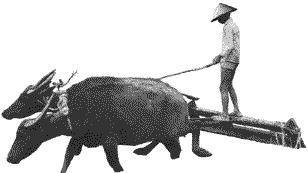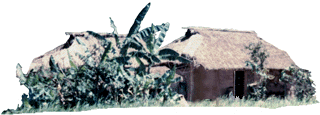The water buffalo is common in the southern regions of Vietnam. It
is a large black animal with huge curving horns. The horns start from a broad base
and taper to a point about a foot and a half away. The buffalo are domesticated and
peasants use them as draft animals. In scenes reminiscent of National Geographic
photographs, we would see buffalo pulling crude plows - long poles with a bisecting board
- to gouge the flooded earth. By comparison, the people are small, some hardly
taller than their animals. Yet even the littlest child can lead a buffalo about by
means of a metal ring in the animals' nose. To see them ambling slowly down the
road, urged on by the occasional slap of a stick, you would think them the most gentle and
peaceful of animals.
We quickly learned how deceiving appearances can be. At the first scent of a GI,
these bucolic cows, these picturesque beasts of labor, turn into wild-eyed snorting
man-killers. My first encounter came as we were walking across a dry paddy bordered
with bamboo hedgerows. Suddenly the sound of crashing brush signaled the arrival of
the Vietnamese version of man's best friend. I just stood there transfixed - nobody
had told me to expect this sort of thing. I was ready for booby traps, mortar fire,
or a sudden ambush - but not for barnyard animals on the rampage!
Fortunately I was in the company of seasoned veterans - this was not their first
buffalo attack. Two or three flipped their safeties and opened fire. They
didn't aim directly at the animal, but rather just in front of it. The beast had
wits enough to turn and exit the way it had come. But I learned that we killed
several of them a month - the ones that didn't stop. And then the US government gave
the unfortunate farmer $100 to replace the cow. This was the Vietnamese equivalent
of winning the million-dollar state lottery. You can guess just how long it took the
farmer to train another attack buffalo!
Why did they attack us? I'm not sure, but I have a theory. Many animals
have a much better sense of smell than we. To the trained nose there is probably a
big difference between Vietnamese and GIs. And not just because we didn't take
baths, either, but because Americans eat meat! To the water buffalo, we may have
been considered carnivores - just like the tigers. A buffalo will attack a tiger to
protect itself or its herd. Perhaps they were treating us the same way.
These encounters always took place when we were least expecting them. Like the
time we were walking through a village and a water buffalo caught wind of us and came
bellowing around the corner of the hootch in front of us. There was no time to
think. Three of us ran through the narrow door of the hootch. The animal
followed, crashing down one wall as he came right through the door. That only
hastened our departure through the rear door. The open space to the next hootch was
about 25 feet - we cleared it in a few bounds (excuse me for speaking in the plural - I
was leading the rout and what the two guys behind me did I can only guess, because I
didn't take time to look!). The buffalo crashed through the back opening as easily
as the front and continued after us.
 The walls of these hootches
were made of mud plastered around a bamboo framework, with solid bamboo poles framing the
doors. A tank would have had to work hard to breach them, but this animal was doing
it without even trying. He was furious and his heavy snorts urged us on. We
ran into the second hootch and out again without stopping, the buffalo close behind.
The buffalo wasn't gaining, but he wasn't quitting either. We turned and went
through a third hootch. The beast crashed into the entrance, and finally stopped,
his horns lodged in the narrow doorway. We just kept on running.
The walls of these hootches
were made of mud plastered around a bamboo framework, with solid bamboo poles framing the
doors. A tank would have had to work hard to breach them, but this animal was doing
it without even trying. He was furious and his heavy snorts urged us on. We
ran into the second hootch and out again without stopping, the buffalo close behind.
The buffalo wasn't gaining, but he wasn't quitting either. We turned and went
through a third hootch. The beast crashed into the entrance, and finally stopped,
his horns lodged in the narrow doorway. We just kept on running.
When the animals couldn't attack us, their fight or flight alternative was to get out
of the area as fast as possible. Once on roadside guard duty I watched a buffalo
cart make its way slowly across the back roads to our outpost. Two animals pulled
the cart, a rickety affair made with a flat platform mounted over a central axle, with two
heavy wooden wheels, and a long pole as tongue to which the animals were fastened by a
simple rope harness. There were two sideboards, and a plain bench seat carrying two
passengers, one an older man driving the cart and the other a bit younger, though I
couldn't tell his age.
I stopped the cart as it came to our outpost. Any Vietnamese male between the
ages of 18 and 40 was required to be in the Armed Forces. Unless a young man had
been discharged because of injury, he was considered to be VC. The older man, with
white hair and a long, thin white beard, climbed down. He walked to where I was
standing, at the right rear of the cart, and handed me his ID card. I looked at it
carefully while keeping an eye on the younger man on the cart. Of course, I couldn't
read Vietnamese, but he didn't know that so I gave him my "It's O.K. this time,
Sir..." look, and returned his card.
As he returned to the cart I motioned to the younger man to give me his card. He
hesitated, then placed it down on the bed of the cart behind him, just out of my reach.
The old man had regained his seat and the reins as I leaned forward across the cart
to get the card.
At that moment the buffaloes caught my scent. One of them reared slightly off the
ground in surprise and fright, and they both started snorting and doing a buffalo version
of the twist. I just stood there, not knowing whether to shoot or run. Then
they bolted. The sudden takeoff hurled the younger man right off the cart. The
older man had the reins, and bounced up and down on the bench as the animals left the
road, mounted the berm beside it and headed out across the rough open meadow beyond.
Once on the level the buffaloes picked up speed, and the cart bounced and jolted as
it hit one mound or bush after another. Now the wrinkled old man was on his feet,
knees slightly bent, at a half-crouch, struggling to hang on and stop the rout, looking
just like Ben Hur coming around the final turn and heading for the wire. But the
terrain had the best of him. One by one the side panels flew off, then the bench.
Now he was alone on the platform, with the noise of their flight whipping the
animals on. One, two, three bounces, each one higher than the last, and the driver
was thrown into the air and down.
He rolled once or twice and came to a stop. The cart quickly followed, flipped on
its side and splintering into dozens of pieces. The water buffaloes raced on alone
with the long tongue and a few pieces of the cart still attached.
Nearby villagers finally halted the runaways. The younger man ran off to help the
elder, and though the old man limped a bit when he got up, he didn't seem to be seriously
hurt. And of course, I felt awful. Even though they might have been enemy -
the old man may have spooked the buffalo on purpose - chances are they were just going
about their business. But not knowing their language, there was no way I could even
say I was sorry.
